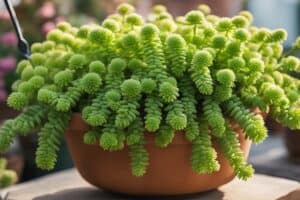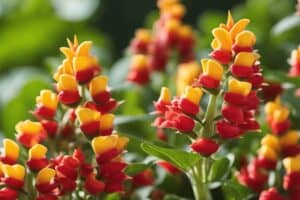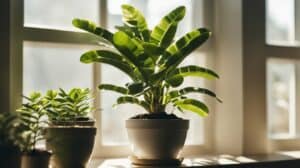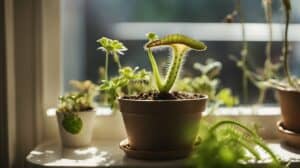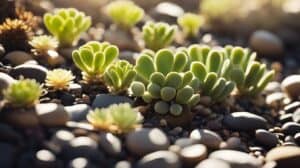Exotic plants are a great way to add some unique flair to any indoor or outdoor space. One such plant is the African Mask Plant, also known as Alocasia ‘Polly’. With its striking leaves and easy propagation, it’s no wonder this plant is becoming increasingly popular among plant enthusiasts.

African Mask Plants are native to tropical regions of Asia and Eastern Australia, but they have become a favorite among houseplant lovers around the world. The plant gets its name from its large, shield-shaped leaves that resemble the masks worn in traditional African ceremonies. The leaves are dark green with white veins and can grow up to two feet long, making a bold statement in any room. In addition to its unique appearance, the African Mask Plant is also relatively easy to propagate, making it a great choice for those looking to expand their plant collection.
Understanding Alocasia ‘Polly’
Species Background
Alocasia ‘Polly’, also known as African Mask Plant, is a hybrid plant that belongs to the Araceae family. It is a popular ornamental plant that is native to Southeast Asia. The plant is a cross between Alocasia sanderiana and Alocasia watsoniana, and it was first bred in the 1950s.
The plant gets its name from the unique shape of its leaves, which resemble the masks worn by African tribes. The leaves are arrow-shaped and have a glossy texture. They are dark green with white veins, and they can grow up to 2 feet long.
Growth Characteristics
Alocasia ‘Polly’ is a fast-growing plant that can grow up to 2-3 feet tall and wide. It prefers well-draining soil and indirect sunlight. The plant can tolerate some shade, but it needs bright light to produce its signature glossy leaves.
The plant is also known for its ability to purify the air. It can remove harmful toxins such as benzene, formaldehyde, and xylene from the air, making it a great addition to any home or office.
Propagation of Alocasia ‘Polly’ can be done through division, stem cuttings, or seed propagation. It is important to note that the plant is toxic to pets and humans if ingested, so it should be kept out of reach of children and pets.
Overall, Alocasia ‘Polly’ is a beautiful and unique plant that can add a touch of exotic elegance to any space. With proper care and propagation techniques, this plant can thrive and bring joy to its owner for years to come.
Propagation Basics

Best Time to Propagate
The best time to propagate the African Mask Plant is during the spring and summer months. This is when the plant is actively growing and producing new shoots. Propagation during these months will increase the success rate of the process.
Required Tools and Materials
Before starting the propagation process, gather the following tools and materials:
- A sharp, sterile knife or pair of scissors
- A clean container filled with well-draining soil
- A plastic bag or container to cover the cutting
- Rooting hormone (optional)
Make sure to sterilize the cutting tool to prevent the spread of diseases. The container should have drainage holes to prevent waterlogging. The plastic bag or container will create a humid environment for the cutting to encourage root growth. Rooting hormone can increase the success rate of the propagation process, but it is not necessary.
By following these basic tips, propagating the African Mask Plant can be a fun and rewarding experience.
Step-by-Step Propagation Guide

Propagating African Mask Plant (Alocasia ‘Polly’) is an easy and rewarding process that can be accomplished through separating rhizomes, rooting in water, or planting in soil. Here is a step-by-step guide on how to propagate this exotic and elegant plant.
Separating Rhizomes
- Carefully remove the African Mask Plant from its pot and gently shake off any excess soil.
- Locate the rhizome, which is the thick stem-like structure that grows horizontally beneath the soil surface.
- Use a clean and sharp knife to cut the rhizome into sections, making sure each section has at least one healthy leaf and root system.
- Dust the cut ends with a rooting hormone to promote healthy growth.
- Plant each section in a well-draining potting mix, making sure the top of the rhizome is level with the soil surface.
- Water the newly planted sections thoroughly and place them in a bright, indirect light location.
Rooting in Water
- Cut a healthy leaf from the African Mask Plant, making sure it has a stem attached.
- Fill a jar or vase with clean water and place the stem in the water, making sure the bottom of the stem is submerged.
- Change the water every few days to prevent bacterial growth.
- After a few weeks, roots should begin to grow from the base of the stem.
- Once the roots are a few inches long, carefully transplant the rooted stem into a well-draining potting mix.
- Water the newly planted stem thoroughly and place it in a bright, indirect light location.
Planting in Soil
- Take a healthy leaf cutting from the African Mask Plant, making sure it has a stem attached.
- Dip the cut end of the stem in a rooting hormone to promote healthy growth.
- Plant the stem in a well-draining potting mix, making sure the top of the stem is level with the soil surface.
- Water the newly planted stem thoroughly and place it in a bright, indirect light location.
- Keep the soil moist but not waterlogged and avoid direct sunlight.
- After a few weeks, new growth should appear from the base of the stem.
Post-Propagation Care

After propagating an African Mask Plant (Alocasia ‘Polly’), it is important to provide proper care to ensure its continued growth and health. This section will cover the basics of post-propagation care, including watering and feeding, light and temperature, and common pests and diseases.
Watering and Feeding
Alocasia ‘Polly’ requires consistent watering to thrive. Water the plant thoroughly, allowing the soil to drain completely before replacing it in its decorative pot. During the growing season, which is typically from spring to fall, water the plant once a week. In the winter, reduce watering to once every two weeks.
Fertilizing is also important for the plant’s growth and health. Feed the plant every two weeks during the growing season with a balanced fertilizer. Reduce feeding to once a month in the winter.
Light and Temperature
Alocasia ‘Polly’ prefers bright, indirect light. Direct sunlight can burn the plant’s leaves, while too little light can cause the leaves to become pale and yellow. Place the plant near a window that receives bright, indirect light.
The plant also prefers warm temperatures between 65 and 80 degrees Fahrenheit. Keep the plant away from drafts and cold temperatures, which can cause damage to the leaves.
Common Pests and Diseases
Alocasia ‘Polly’ is susceptible to common houseplant pests such as spider mites and mealybugs. Regularly inspect the plant for signs of infestation and treat with an insecticidal soap or neem oil as necessary.
The plant can also be prone to root rot if overwatered or if the soil does not drain properly. Ensure that the soil is well-draining and allow it to dry out slightly between waterings to prevent root rot.
By following these basic care tips, Alocasia ‘Polly’ can continue to thrive and add exotic elegance to any indoor space.
Frequently Asked Questions

How do I propagate an Alocasia ‘Polly’ using water?
To propagate an Alocasia ‘Polly’ using water, start by selecting a healthy leaf from the parent plant. Cut the leaf stem and place the leaf in a container of water, making sure the leaf is partially submerged. Keep the container in a warm, bright location and change the water every few days. After a few weeks, small roots should start to appear. Once the roots are about an inch long, the leaf can be planted in soil.
What are the steps for propagating Alocasia ‘Polly’ from leaf cuttings?
To propagate Alocasia ‘Polly’ from leaf cuttings, start by selecting a healthy leaf from the parent plant. Cut the leaf stem and make sure there is a portion of the corm attached to the stem. Plant the stem in well-draining soil and keep it moist. Place the pot in a warm, bright location and wait for new growth to appear.
Can Alocasia ‘Polly’ be propagated from corms, and if so, how?
Yes, Alocasia ‘Polly’ can be propagated from corms. To do this, carefully remove the corm from the parent plant and cut it into sections, making sure each section has at least one eye. Plant the sections in well-draining soil and keep them moist. Place the pot in a warm, bright location and wait for new growth to appear.
What care should be taken after propagating an Alocasia ‘Polly’ plant?
After propagating an Alocasia ‘Polly’ plant, it is important to keep the soil moist and to avoid overwatering. Place the plant in a warm, bright location and avoid direct sunlight. Fertilize the plant regularly with a balanced fertilizer.
How often does Alocasia ‘Polly’ produce flowers, and does it affect propagation?
Alocasia ‘Polly’ rarely produces flowers when grown indoors. Even if it does produce flowers, it is unlikely to affect propagation as the plant is usually propagated through vegetative means.
Is it possible to propagate Alocasia ‘Polly’ from stem cuttings, and what is the process?
Yes, it is possible to propagate Alocasia ‘Polly’ from stem cuttings. To do this, select a healthy stem from the parent plant and cut it into sections, making sure each section has at least one leaf. Plant the sections in well-draining soil and keep them moist. Place the pot in a warm, bright location and wait for new growth to appear.








